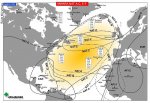KB2GOM
Active Member
There appears to be NAT-A through NAT-F, and a handful of frequencies for each . . . how do you decide which frequencies to monitor when?
There is absolutely no difference in propagation between HF amateur or any other HF service. There isn't nearly the traffic that there used to be because of the use of digital (HFDL) and satellites, so it's simply a matter of trying the various freqs and seeing what is propagating to your area.
The good thing is that HFDL is very easy to monitor, there's software available ; just connecting the PC and radio together is a bit of a tussle because most newer PCs don't have line in jacks anymore. You have to use a USB soundcard for this
Mike
<snip>.
Are there any propagation tools that you can recommend for getting closer to the right frequencies? I've been checking WWV at 5, 10, and 15 megs to use as a rough guide.

While there are numerous tools - including the popular VOACAP - that can help with this, you should know that the predictions given by software are an estimation - nothing substitutes for using your ears to tell you how a particular band is doing.
That software and many related pages can be found linked here...

HF Propagation - The RadioReference Wiki
wiki.radioreference.com
Mike
Here is info I copied back in 2000 from a comm card by an HF radio at an airshow.
There appears to be NAT-A through NAT-F, and a handful of frequencies for each . . . how do you decide which frequencies to monitor when?
Eastbound entering Gander Oceanic airspace the initial HF frequency is assigned by Gander Radio on VHF. Covered by this LiveATC feed at CYYT.
Eastbound approaching 30W the Shanwick HF frequency is assigned by Gander Oceanic using SATCOM/CPDLC. Covered by this SATCOM CPDLC website.
Eastbound entering New York Oceanic airspace the initial HF frequency is assigned by New York ARINC on VHF. Covered by this LiveATC New York ARINC feed.
Westbound entering Shanwick Oceanic airspace the HF frequencies for Shanwick and Gander are assigned by either Shannon ATC or Shanwick Radio using either VHF or CPDLC. Covered by these Shannon Control 1 and Shannon Control 2 feeds.
Monitoring these sources you will be able to determine what HF frequencies are currently in use.
New York Oceanic frequencies are also displayed here on the ARINC website. Although they are not always accurate.
You might want to pay attention to the NAT-D family. Gander Radio handles the "over the pole" traffic in addition to the North Atlantic traffic out to 30W. Currently listening to Gander on 8891 passing the active frequency for Magadan (Russia) to a United flight in addition to working various North Atlantic flights on the same frequency.

The BTown list has been updated on 5th June 2021.
here are 24 listed here not including SAR and VOLMET and the duplication of 13291 in 3 different families.
Pre-covid I've only logged these 13 Shanwick MWARA frequencies as active - 2872, 2971, 3446, 3476, 4651, 5583, 5649, 6547, 6595, 6622, 8872, 8879, 10021.
Am I blind or are there no actual HF frequencies in that document? Just XA, XB, etc? All statistics, no help to us? There's some mention of VHF specifics.

